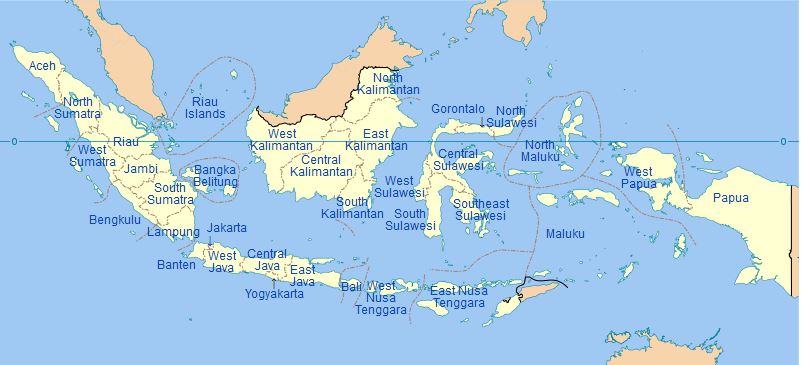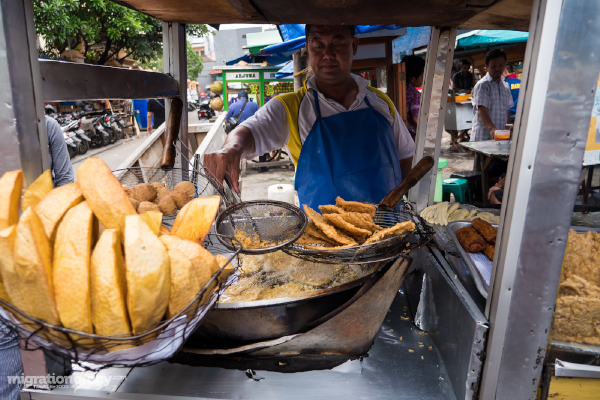I hasten to point out that Indonesia is a far-flung land of islands – some only a few dozen square miles / km in area and others as vast as you could possibly imagine. Maybe bigger. Indonesia is the world’s largest island country, and the world’s fourth-most populous country.
 Indonesia: The world’s largest island country, Indonesia is the world’s fourth-most
Indonesia: The world’s largest island country, Indonesia is the world’s fourth-most
populous country and the most populous Muslim-majority country.
With that in mind, it’s truly amazing that all these cultural entities could ever come together in a single country, with a single motto: ‘Unity in Diversity’ (literally, ‘many, yet one’), and agree on a single national language. But, after hundreds of years of common-cause fighting against major trading powers such as the Portuguese and Dutch, an later the empire-building Japanese, the various scattered entities came together under one flag and proclaimed themselves a single nation. It took a while. Not until Two days after the surrender of Japan in August 1945, did Sukarno (one of the most famous figures in Indonesian unification, and one of the first modern politicians to go by a single name; like Lenin or Geronimo) and Mohammad Hatta, influential nationalist leaders, proclaimed Indonesian independence.
The name Indonesia derives from Greek words of Indos (Ἰνδός) and nesos (νῆσος), meaning: ‘Indian islands’, and dates to the 18th century.
Indonesia today
Wikipedia provides as clear and concise a description of the nation’s current composition and place in the world as any you’ll find in any contemporary reference work:
“Indonesia, officially the Republic of Indonesia, is a country in Southeast Asia and Oceania between the Indian and Pacific oceans. It consists of more than seventeen thousand islands, including Sumatra, Java, Sulawesi, and parts of Borneo and New Guinea. Indonesia is the world’s largest island country, the world’s fourth-most populous country and the most populous Muslim-majority country. Java, the world’s most populous island, is home to more than half of the country’s population.
“The sovereign state is a presidential, constitutional republic with an elected legislature. The country’s capital, Jakarta, is the second-most populous urban area in the world. The country shares land borders with Papua New Guinea, East Timor, and the eastern part of Malaysia. Other neighbouring countries include Singapore, Vietnam, the Philippines, Australia, Palau, and India’s Andaman and Nicobar Islands. Despite its large population and densely populated regions, Indonesia has vast areas of wilderness that support one of the world’s highest levels of biodiversity.”
The only question I have is, why haven’t we heard much more about this amazing place?
The overall approach to an expedition
As you can see, we have more than one ‘place’ to explore when we talk about surveying the ‘national’ cuisine of Indonesia!
We could use, as an example, the differentiation between regions that prefer Sambal Olek (hot pepper relish) and those who prefer Sriracha. Or those who prefer rice to those who prefer noodles. There are lots of other potential dividing lines we could choose from at random. But I propose we look at various foods and styles of cooking as rallying points by which to split Indonesian cuisine into manageable, bite-sized chunks…
 Gorengan: A typical Gorengan (Indonesian street food) cart. They’re everywhere.
Gorengan: A typical Gorengan (Indonesian street food) cart. They’re everywhere.
Familiar words and concepts
We all know a few of the more famous Indonesian dishes by name, some of the most popular ingredients, and some of the styles of cooking:
Sate (Satay) is a popular a style of cooking distinguished by the use of wooden skewers and strong spicy sauces. Many different meats are used. As are many, many Indonesian foods, Sate originated and in it’s native land is still considered a ubiquitous street food.
Bakar is the Indonesian word for ‘pan fried’. The country’s cuisine is noted for its tradition of pan frying whole small fish (with or without coating of some kind). Just about any food can be prepared ‘Bakar’.
Goreng means ‘deep fried’.
SOP is (one guess) ‘soup’.
Nasi is ‘rice’.
Rendang is that wonderful, nasal-passage-clearing dish which can have any meat (chicken, beef, goat, whatever) that’s made by rubbing/coating middle sized chunks of meat with a robust spice mixture and stewing or roasting it in a small amount of liquid.
Gorengan is the coverall name for a collection of popular deep fried street food snacks, sold from street carts that are everywhere you go in Jakarta. Just like Hot Dogs in New York City.
Tempeh is a fermented soy bean concoction. (Similar to Tofu).
Sambal is the national catch-all word for Chili Sauce. It comes in mild to raging hot, and sweet to sour as citrus from all corners of the country.
Tomorrow…
We’ll talk about ingredients that are either common to a large proportion of Indonesian dishes, or (all but) unique to Indonesian cooking…
Cheers!
~ Maggie J.

